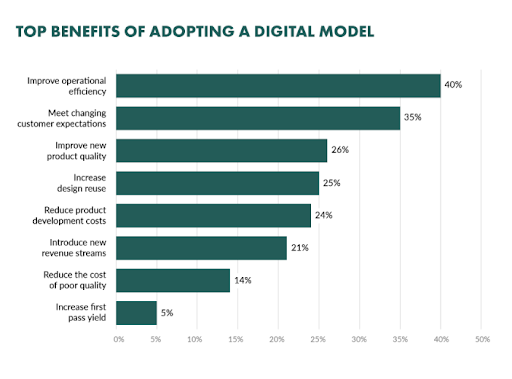
The concept of digital workplaces has become especially relevant in the past year, as many companies have moved to remote working. But what is a digital workplace exactly? This blog post will discuss what a digital workplace is, why it’s important, and some examples of how businesses are leveraging it.
What is a digital workplace?
A digital workplace is an environment where technology enables employees to work from anywhere at any time.
Using tools such as cloud computing and video conferencing, employees no longer need to collaborate physically in the same office or workspace. Instead, they can access data and resources remotely and communicate with one another through various channels such as email, project management software, chat apps and more.
Why is it important to implement digital technology in the workplace?
The digital workplace concept has become increasingly important due to the recent shift to remote working caused by the pandemic. The explosive rise of hybrid working has drastically transformed the technological landscape. From vast improvements in internet connection and computing power to the development of cloud technology, digital communication platforms, and better security — the future of work is now.
Thanks to virtual meeting tools and applications, the 9 to 5 commute is a thing of the past. Now, employees can work from any device, on any platform, from different cities or anywhere in the world. The digital workplace is location-agnostic, changing the way companies and employees operate.
By providing employees access to data and resources from anywhere worldwide, businesses can remain productive even when their staff are not physically present in the same office. In addition, digital workplaces reduce overhead costs for employers since they don’t have to invest in physical office space or equipment for their employees.
Digital workplace transformation is disrupting the business landscape — and the customer is driving it. Today’s customers expect relevant content anytime, anywhere, on any device. Companies need to embrace technology to meet these expectations and put the customer first.
We’re seeing this shift in strategy from many organisations, with 35% of business executives claiming that digital transformation helps them to better meet customer expectations and improve operational efficiency (40%). And 38% of executives plan to invest more in technology to make it their competitive advantage. It’s clear that adapting to the new market reality is key to success.
Related Reading: 8 Takeaways from Cloudbooking’s Research on the Future of the Workplace
Examples of digital workplace technology
1. Synchronous and asynchronous communication channels
The digital workplace has revolutionised how teams communicate, regardless of their location and the devices they use. With synchronous communication, teams are no longer restricted by physical boundaries, allowing real-time interaction. Knowledge sharing is made more accessible, even when team members cannot meet face-to-face daily.
Synchronous communication channels allow for real-time communication, such as live chat, video conferencing, and instant messaging. These communication channels are typically used when all participants need to be able to communicate with each other simultaneously, such as during a meeting or a group discussion.
On the other hand, asynchronous communication channels do not require participants to be available simultaneously. Examples of asynchronous communication channels include email, forums, and discussion boards. These communication channels are often used when participants don’t need to be available at the same time, such as when sharing information or updates or when discussing a project or task.
2. Analytics
A digital workplace strategy is nothing without the implementation of intelligent analytics tools. Businesses can create clear and cohesive analytics and make informed decisions by transforming dissonant data into actionable insights. With automated data analysis and powerful insights, your business can enjoy higher productivity with minimal effort.
Digital workplace analytics typically involves collecting data from various sources, including employee surveys, usage logs, and performance metrics. This data is then analysed using various tools and techniques, such as data mining, machine learning, and natural language processing. The results of this analysis can provide valuable insights into the strengths and weaknesses of an organisation’s digital workplace and help identify areas where you can make improvements.
Related Reading: Smart Offices: Connecting People & Real Estate with Integrations
3. Digital workplace monitoring tools
Your digital workplace needs the right performance management software to ensure everything is running smoothly. A comprehensive solution that takes a precise look at your entire unified communication environment can help identify and address any issues quickly.
From slow logons to session disconnects and screen freezes, these issues can cause major headaches in a dispersed workforce operating between a physical and digital workplace. With the right software, you can ensure your workforce remains productive and efficient, no matter the device or communication app.
Some examples of digital workplace monitoring tools include employee activity monitoring software, collaboration tools, and project management software. These tools can help organisations optimise their digital technologies’ use, improving collaboration, communication, and productivity.
4. Project management
The digital workplace helps teams take projects from concept to completion like a well-oiled machine. Establishing policies, procedures, and principles allows for better project management and ensures all departments have what they need to work together efficiently. Plus, teams can create, collaborate on, and track projects in one platform, ensuring no deadlines are missed and that all project information is easily accessible.
It can also help to reduce the amount of paper and other physical materials used in the project management process, which can be more environmentally friendly and cost-effective.
Related reading: The Cloudbooking Guide to Planning Productive Hybrid Meetings
5. Process management
Process management helps companies take a closer look at their inner workings and pinpoint areas of improvement. Digital process management can include process automation software, workflow management tools, and other digital technologies to help businesses easily digitise their internal business processes and create streamlined workflows. Automating the repetitive, routine, and predictable parts of a process saves employees time and allows them to focus their energy on more important tasks.
Digital process management can provide many benefits, including improved efficiency, reduced errors and waste, and better tracking and control of processes. It can also enhance collaboration and communication among team members and make it easier for organisations to adapt to changing business needs and requirements.
6. Case management
From customer complaints to service requests, case management allows your workforce to handle multiple cases with a single interface. This method of processing information combines digitised workflows and human decision-making, making it easier to effectively collaborate and prioritise cases, enabling quick and efficient resolutions. Put simply, case management makes it easier to get the job done.
Related reading: 5 Ways to Create a Recession-Proof Workplace
7. Cost savings and increased revenue
Taking all of the above benefits into account, a digital workplace can increase business revenue in several ways. First, digital tools and technologies can improve collaboration, communication, and productivity within an organisation, which can help drive business growth and success. For example, by using project management software, teams can work more efficiently and effectively, resulting in better project outcomes and increased revenue.
Second, a digital workplace can also help reduce costs and improve efficiency, directly impacting the bottom line. For example, using digital process management tools can streamline and automate business processes, reducing the need for manual labour and resulting in cost savings.
Third, a digital workplace can help companies better serve their customers and clients, increasing customer satisfaction and loyalty. For example, digital case management tools can help businesses handle customer inquiries and complaints more efficiently, resulting in improved customer service and increased revenue.
Is it time to digitally enhance your workplace?
A robust digital workplace is essential for success in today’s modern business landscape. Businesses can remain productive even when their staff aren’t physically present in the same office space by providing access to data and resources remotely and facilitating communication between employees through various channels such as chat apps or video conferences.
With so many benefits associated with having a modernised digital workplace strategy – increased efficiency and cost savings — it’s clear why more employers are moving away from traditional office settings towards remote working environments enabled by technology.
Cloudbooking’s system integrations can streamline the management of workplaces with connected tools that enhance workspace scheduling and create a seamless experience for employees and visitors. Contact us now for a no-obligation product demo.



